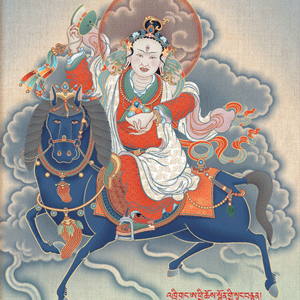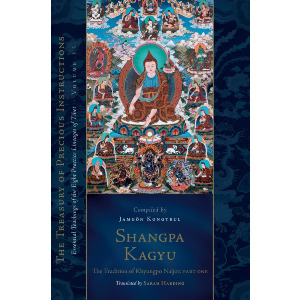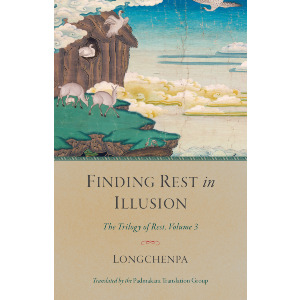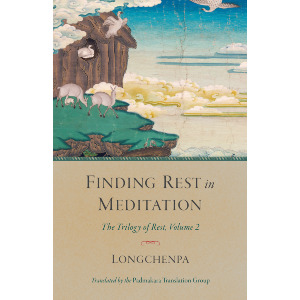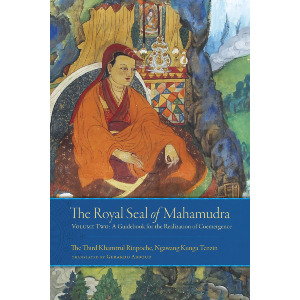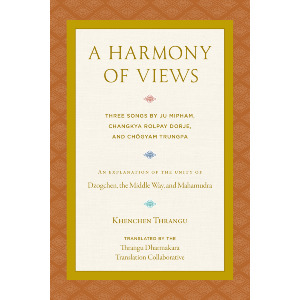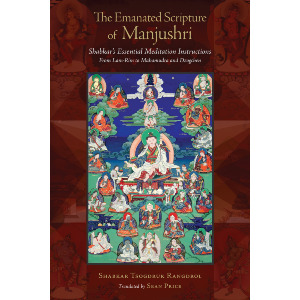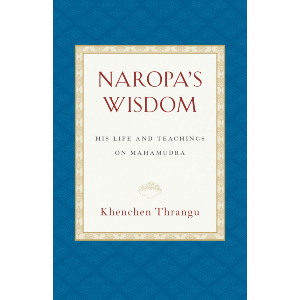| The following article is from the Summer, 1999 issue of the Snow Lion Newsletter and is for historical reference only. You can see this in context of the original newsletter here. |
Mahamudra represents the highest level of teaching within Tibetan Buddhism. Its study and practice leads to the realization of the very nature of reality itself—there is not a single phenomenon which is not subsumed within the realizations of Mahamudra.
In 1994, H.H. Chetsang Rinpoche toured the USA and gave detailed instructions in Mahamudra methods based on the ancient traditions of Tibet and India. He carefully explained each of the five stages of Mahamudra and taught many meditation practices. His Holiness also gave precise instructions on meditative posture and breathing and responded with helpful answers to student's questions using the teachings of Tilopa and Gampopa to illustrate various points.
This book is a record of His Holiness' teachings on Mahamudra, and is the clearest presentation of Mahamudra meditation practice available.
His Holiness Chetsang Rinpoche was born in 1946 in Lhasa, Tibet into the well-known Tsarong family. In 1949, he was recognized as the 37th Drikung Kyabgon, head of the Drikung Kagyu order of Tibetan Buddhism. He has worked tirelessly to renew and spread its academic and meditative traditions in many countries including the USA.
Following is an excerpt from The Practice of Mahamudra.
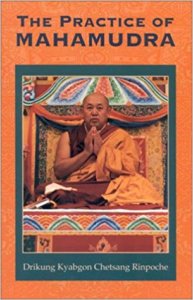
Snow Lion Publications, 1999 Edition, Ithaca, NY USA
The Attainment of Non-attainment
Once, Tilopa advised his disciple to go off to an isolated retreat and avoid any meditation. Now, this may seem a little unusual for a meditation retreat. He explains, however, that when you go to meditate, you normally take up something to meditate on, some thing. That thing, and therefore that meditation, is necessarily artificial. The practice of Mahamudra is not like that at all. It is not taking up a thing called Mahamudra and meditating on it. Ultimately, Mahamudra practice is meditation directly on reality itself.
there is not a single phenomenon which is not subsumed within the realizations of Mahamudra... Ultimately, Mahamudra practice is meditation directly on reality itself.
Reality itself is not something devised or made up. What you have to do here is accustom yourself to that, practice that. You are not taking up a meditation, but rather are practicing something. Like any activity, when you practice and become accustomed to it, it becomes easier and easier. So, acquaint yourself with this lack of anything whatsoever to be taken up as a discrete object.
Focus on reality itself and become accustomed to that. Tilopa's advice, then, is that if you attain something by this Mahamudra practice, then you have not attained Mahamudra. Attaining Mahamudra is attaining non-attainment. If you are not getting anything, then you're getting Mahamudra. If you get some thing, then necessarily it is not Mahamudra.
Attaining Mahamudra is attaining non-attainment. If you are not getting anything, then you're getting Mahamudra.
What is the meaning of this? If, when we strive for Buddhahood, we think that Buddhahood is something that we are going to get, we will be making a great mistake. We would be like hunters going after an animal. Buddhahood would be reduced to just another worldly activity in which we engage to get some pleasure for ourselves.
Mahamudra is not like that, it is not some thing to be obtained. It is attaining the state of non-attainment. Understanding that, we do not focus on obtaining something but on transcending. We have to get beyond that search for something to grasp onto.
Now the nature of reality is beyond the illusion of the phenomenal world, the world as it appears. What appears is illusory; reality is something else. So, when engaging in this meditation on Mahamudra, one seeks to realize Mahamudra. As long as it is something that is an object of mind, something that is conceived by mind, then is it necessarily something other than Mahamudra.
Mahamudra is not a conception, not something which is of the nature of appearances or of the nature of objects of the conventional mind.
the nature of reality is beyond the illusion of the phenomenal world, the world as it appears.
Therefore, whatever we look for, whatever we try to hold on to in terms of objects of mind, is not going to be Mahamudra. It is something other than that. It is not of the nature of the phenomenal world in any sense. As long as we conceive of it as something, we are making a mistake and will not attain the realization of Mahamudra in that way.
Tilopa's advice is that if the disciple wishes to see Mahamudra, the disciple must go beyond conventional mind and abandon worldly involvement, because the conventional mind and worldly activities are what obscure the realization of Mahamudra and can never lead to it.
Search, then, for mind itself.
Search for the perceiver or the meditator, the essential nature of the one who is seeking the realization.
Turn your search inward and seek mind itself.
Abandon all the coverings of mind which are like clothing—all the things which are associated with it and which one thinks of in terms of what mind is.
All of these are like clothing, and the search is for the naked mind, the unclothed mind, mind in its very essential essence.
All of the conventional attributes of mind are just concepts, things we must transcend in order to penetrate to the very core of the essential mind itself. To see the nature of reality, to realize Mahamudra, it is necessary to abandon involvement in the world.
As long as we conceive of it as something, we are making a mistake
In practice, this actually means to get rid of inner involvements. Inner involvements are the kleshas, the unwholesome negative mental activities of desire, aversion, delusion, and so forth. These are what must be abandoned, or dispelled. The technique for dispelling these is the practice of shamatha.
The example given here is a pool of water. If you want to see the depths of the water, one must clear out the mud, the defilements, in the water that makes it impossible for you to see the bottom. So the kleshas—greed, hatred, delusion, and so forth—are like the mud that fills the pond. Until all that mud settles out, you cannot see the bottom. It is the practice of mental quiescence that allows all of these kleshas to cease.
Then with vipashyana, you can see through the clear water to the essential nature of reality. And so, the realization of Mahamudra is not the creation of something which was not there, nor is it the removal of something.
In other words, to realize Mahamudra you do not get rid of or abandon appearances; they are not what is obstructing the view. Appearances can be allowed to stand just as they are. Nor is there anything to be achieved or produced. There is nothing to be obtained from reality to realize Mahamudra. Rather, through the practice of mental quiescence, allow the disturbing tendencies to subside and then reality will appear by itself.
It is the practice of mental quiescence that allows all of these kleshas to cease... There is nothing to be obtained from reality to realize Mahamudra.
The realization of ultimate reality can be approached in various ways by developing insight through establishing the correct philosophical view.
With regard to the various inner and outer phenomena, one can gradually learn the right and the wrong in terms of the view and develop the realization of one thing after another. In this way, a realization can gradually build up. However, the most effective way is to get at the very root of delusion and cut it off. Once this is cut off, the trunk, the leaves, the stems, and the branches of the tree of illusion will wither and die. So rather than remove them one at a time, it's best to go right to the root of delusion.
The way this is done in practice is to look at the essential nature of mind. Once that has been realized in its true nature, the root of delusion is destroyed and all the delusions with regard to all other appearances of the world will cease.
The realities of the inner and outer worlds will be realized together. Through this process of realizing ultimate reality by looking at the essential nature of mind itself, the root of all delusion is destroyed and one sees reality, the inner and outer, as it actually is.
Once that has been realized in its true nature, the root of delusion is destroyed and all the delusions with regard to all other appearances of the world will cease.
In the process of doing this, one also removes all the defilements from beginningless time. In all of our past lifetimes—from countless ages ago—we have accumulated vast negative karma, incalculable non-virtuous activities and defilements. If we tried to apply antidotes to each of these and purify them one by one, it would be an interminable task. However, by cutting the root of delusion, we cut the root of all these defilements and remove them all at once. So the direct view, the direct realization of the ultimate truth of Mahamudra, in and of itself destroys all the defilements accumulated from beginningless time.
The practical instructions for engaging in the meditation leading to Mahamudra are given here from the very beginning of the path.
The priority at the beginning is to gain a sense of control whereby mind does not go this way and that, becoming attached to worldly appearances which make it impossible to progress in Mahamudra practice.
This is where the practices related to mental quiescence come into play. The techniques to achieve it are described here. The various meditation techniques, like concentrating on the breath, are explained. The point is not control so much as it is unifying the essence of mind with the breath as it comes in and goes out.
direct realization of the ultimate truth of Mahamudra, in and of itself destroys all the defilements accumulated from beginningless time.
This process can be compared to learning to drive a car. In the beginning, you have to learn how to steer in a rough sense so that the car stays on the road. Later you can drive efficiently and go to your destination. So, these things like the breathing and the focus of your gaze are the necessary controls. Once you gain proficiency in this, mind will settle down, and you can continue more efficiently in this path of meditation. By controlling the eyes and breath, mind itself comes under control.

Having gained control through these techniques, mind is then used to focus on mind itself. When mind focuses on mind itself, the kalpana arise, and these must be cleared away.
unifying the essence of mind with the breath... By controlling the eyes and breath, mind itself comes under control.
Before mind can perceive itself, you must abandon all conceptual ideas; these are not mind. This is said to be like trying to find the center of the sky. The sky in this sense means the vastness of empty space. If we look for something that we can call the center, we will not find anything. Or if we look for the end of space, we will also not find anything. The very nature of space is that it is endless, so finding the center or an edge is impossible.
Similarly, when we look at mind and try to find characteristics like that, we will not find them. These characteristics are conceptual, they are the dichotomies between center and edge, or size or shape or color. We must go beyond these dichotomies of thought in order to see mind in its essential nature.
Viewing the essential nature of mind is compared to viewing the ocean or the sky. If you look at the ocean superficially, your view is obscured by the waves on the surface. If you look at the sky, you just see clouds and not the sky. The waves on the ocean and the clouds in the sky are like the kalpana If we go beyond the waves, we see the depths of the ocean. If we go beyond the clouds, we see the extent of the sky. Likewise, we have to go beyond the kalpana to see the mind. They disappear just like the waves on the ocean and the clouds in the sky. They are not permanent or abiding in their nature. So, by seeing the true nature of mind, all of these kalpana simply dissolve and disappear.
through the practice of mental quiescence, allow the disturbing tendencies to subside and then reality will appear by itself.
Taking the example of the sky, we can see that even though things like clouds appear in the sky, when they disappear, they leave no trace. Colors appear in the sky—the whiteness of dawn and the darkness of midnight. The darkness does not leave a stain; when the sun rises in the morning, it's all gone. Likewise, the colors of the day; although they appear in the sky, they are gone at night without a trace. So the nature of the sky itself is undefiled, unmarked, unstained by that which appears within it. Its nature is that it is non-composed. It is not made up of parts. It is not something which we can define in terms of size, shape, color, or form.
So, like that, mind has various contents which appear in it but do not leave a residue. They just disappear. Mind is also not definable by way of size, shape, color, extent, or any characteristics like that. In its essential nature, mind is identical with the Tathagatagarbha, Buddha-nature. It is also the wisdom of self-knowledge. The wisdom of self-knowledge and Buddha-nature are by their most intrinsic, basic quality free of all attributions. By realizing their nature, all of these adventitious contents are dissolved.
Likewise, mind. Although it has been engaged for countless eons since beginningless time in all sorts of activities, accumulating all sorts of karma and defilements, its very nature is completely unstained by all these things.
The nature of the mind is also compared to space. In empty space, various things arise—various appearances, material objects, worlds, suns, moons. All of these things arise in space and stay there for a very long time, moving this way and that. All of the activities of the world take place in space. But then everything moves on and the space that was filled at one time is empty at another time. Once all of the things have moved on and are no longer present in a certain space, that space is completely empty and completely free of any residue of all that took place there.
Likewise, mind. Although it has been engaged for countless eons since beginningless time in all sorts of activities, accumulating all sorts of karma and defilements, its very nature is completely unstained by all these things. When one realizes the clear light of reality, then all those stains completely disappear, leaving no residue whatsoever in mind.
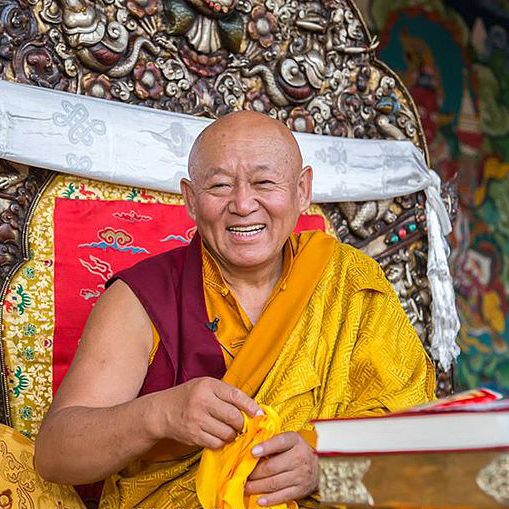
Related Materials:
Mahamudra Topic Page - Discover Books, Courses, Videos, Articles & Events

